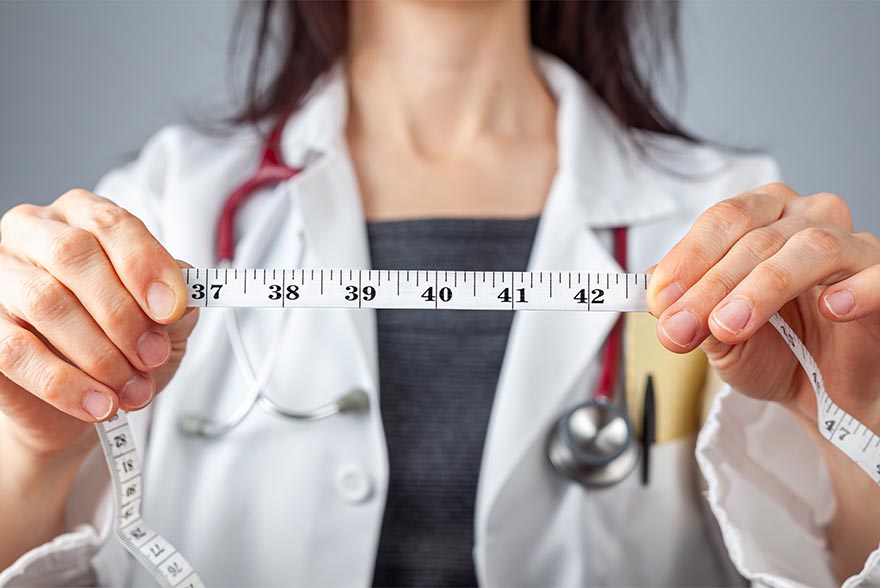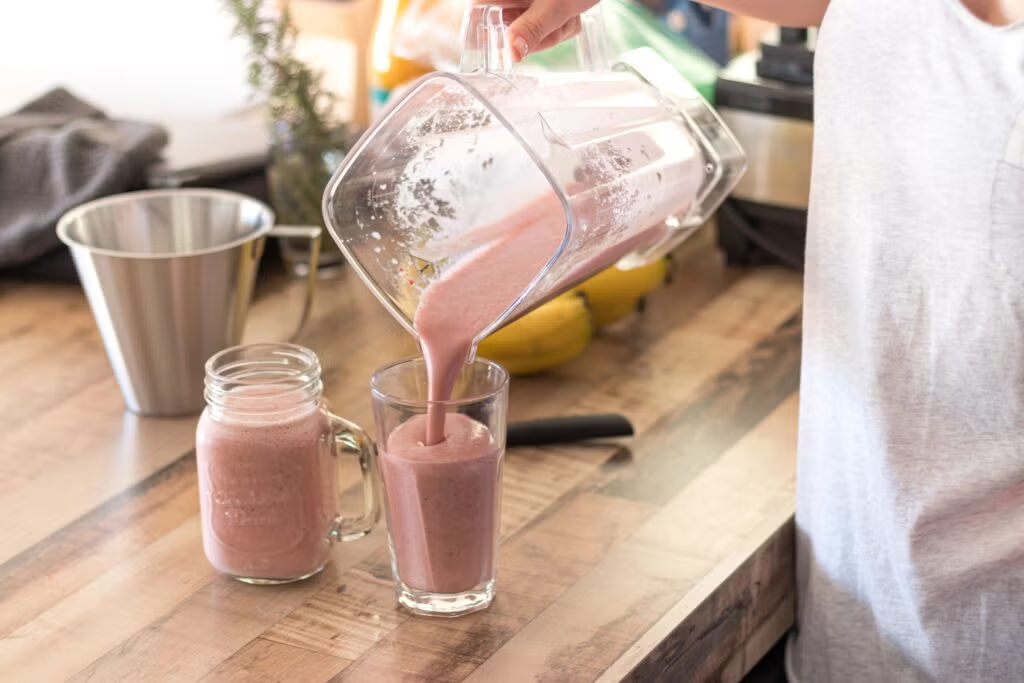
Losing weight is not easy. It takes time, commitment, dedication, and the right tools. The invention of weight loss medications are one tool that has proven to be successful in rapid and substantial weight loss.
Some people may be on a weight loss medication for the rest of their lives while others only use it for a short period of time. Why do people stop taking them? The top reasons people discontinue treatment with GLP-1 receptor agonists (a type of weight loss medication) are related to side effects like GI issues, high cost, disliking injections, or not seeing weight loss or blood sugar results [1].
If you aren’t on the medication forever, what should you do to continue to lose or maintain weight loss?
Surprisingly, there is very little clinical guidance in this area for doctors, dietitians, and healthcare professionals. Since there isn’t an official “life after Ozempic” diet or exercise plan, GNC has gathered all the available scientific evidence to develop the best tips to set you up for success.
What You Need to Know
- Different types of medications are used for weight loss. Many people use these drugs for a period of time and then discontinue treatment due to cost and side effects.
- After weight loss drugs are no longer being used, this can lead to an increase in appetite, poor diet, weight regain, and issues with blood sugar control.
- To prevent these issues, there are diet, exercise, and lifestyle interventions that can help.
- It is important to incorporate a nutritious diet high in protein and fiber, engage in regular exercise, and surround yourself with a support system to ensure long-term success.
- There are also supplements you can consider after coming off of a weight loss medication, such as multivitamins, protein, meal replacements, and more depending on your goal.
How Do Weight Loss Drugs Work?
There are a few different types of weight loss medications. One of the most popular belongs to a class of medications known as GLP-1 receptor agonists (such as Ozempic, Wegovy, Trulicity, and Victoza). GLP-1 (glucagon-like peptide) is a hormone naturally produced by the body. These drugs work by mimicking the action of GLP-1, which helps control blood sugar by impacting two key hormones (insulin and glucagon) and slows gastric emptying (causing feelings of satiety and fullness). This leads to substantial weight loss and improvements in blood sugar control for those with diabetes. Other weight loss drugs like tirzepatide (also known as Zepbound and Mounjaro) work similarly by targeting GLP-1, but they also impact another hormone called glucose-dependent insulinotropic polypeptide (GIP) to decrease appetite [2].
What Happens When You Stop Taking Weight Loss Medications?
But what happens when you stop taking weight loss drugs? For those with diabetes, the medication is no longer helping the body with the balance of insulin and glucagon production, which can lead to elevated or uncontrolled blood sugar levels. For those taking the medication for weight loss, the body no longer has the “I feel full” signals firing from the gut to the brain – which can lead to overeating and regaining weight.
And weight regain is certainly a reality. In a follow-up study, subjects regained two-thirds of their prior weight loss in one year after they stopped semaglutide. Their improvements in various cardiovascular and metabolic markers also tended to revert towards baseline levels, such as C-reactive protein (a measure of inflammation), blood pressure, cholesterol, triglycerides, and hemoglobin A1C (a marker of blood sugar control over time) [3]. In basic terms, they’re losing the health benefits they worked so hard for.
The loss of muscle while taking the medication is another potential concern. Studies have shown that semaglutide can result in a decrease in fat-free mass, which is an indicator of muscle mass [4]. Maintaining muscle mass is especially important for those trying to lose weight because muscle is more metabolically active than fat (aka. it burns more calories).
Healthy Habits After Weight Loss Medications like Ozempic
There is currently no official “diet plan” that is recommended for those who are taking weight loss drugs or just stopped treatment. However, there are important nutrition, exercise, and lifestyle changes that can help along the way – backed by scientific evidence.

Reduce Carbohydrate Intake. In a review of 38 studies, low-carbohydrate diets were shown to be more effective for weight loss than low-fat diets [5]. One reference indicates “low-carb approaches stem primarily from the hypothesis that lowering insulin, a critical hormone that produces an anabolic, fat-storing state, improves cardiometabolic function, and induces weight loss” [6]. Scientifically, there is not a clear consensus on what “low carb” means. Generally speaking, however, low carb has been associated with ~26% of calories from carbohydrates (or 130 grams of carbs per day). For context, the Institute of Medicine recommends Americans consume 45%-65% of calories from carbs.
Since GLP-1 agonists are primarily intended for the treatment of high blood sugar levels in people with diabetes, discontinuing the medication may cause fluctuations in blood sugar. For those who are diabetic, it’s important to follow a diet appropriate for maintaining steady levels of blood sugar throughout the day. Pay close attention to monitoring blood sugar levels before and after meals to determine how your body is responding. You may want to discuss medication adjustments, such as insulin, with your physician. In terms of a diet for those with diabetes, there are a few recommendations from various organizations that can also be applied for any healthy individual trying to lose or maintain their weight, such as reducing carb intake, focusing on fiber, and increasing protein [7].
Increase Protein. Research shows that high protein intake during a calorie-restricted diet helps to maintain lean body mass, especially in older adults [8]. While protein needs vary depending on weight, age, gender, and level of physical activity, I’d generally recommend 0.5 grams of protein per pound of body weight (or more!). For example, if you weigh 200 lbs, you’d want to consume 100 grams of protein per day.
Eat Fiber-Rich Foods. Aim for 28 grams of fiber per day through foods such as non-starchy vegetables, avocadoes, fruits, berries, beans, peas, and lentils. Fiber also helps you to feel full, which is helpful when trying to lose or maintain weight.
Minimize added sugars and refined grains. These are mostly found in pre-packaged foods in the middle of the grocery store. Replace sugary beverages with water or zero-calorie/zero sugar options.
Follow A Healthy Diet After Ozempic or Weight Loss Drugs
How To Put It Into Action
Recipes and Meal Plans
- A great resource is the Diabetes Food Hub where you can find healthy recipes, plan meals, and create grocery lists.
- I really like the “Plate Method” when it comes to eating healthy because it’s very simple and easy to follow. Here’s how it works.
Consider Incorporating These Supplements
Fill Nutrient Gaps with a Multivitamin
No one’s diet is perfect, but it may seem worse after your appetite and cravings come back. Choose a high-quality multivitamin to ensure you’re meeting all your micronutrient needs to support overall health.

Shakes and Supplements for Increased Appetite and Weight Regain
Meal replacement shakes are a convenient way to control calories during weight loss or to maintain your current weight. They’re packed with muscle-protecting protein as well as vitamins and minerals you may be lacking. If you find yourself craving something sweet or indulgent in between meals, reach for a high-protein snack, like a protein bar, which comes in many different flavors.
You can also consider adding a weight loss pill into your daily routine. These have gotten a bad rap through the years, but you can trust GNC to have a wide selection of products to fit your needs.
Products for Blood Sugar Support
Protein powders and fiber supplements are a great combo to not only help you feel full, but help control blood sugar spikes. You could also try a supplement specifically designed for blood sugar support. These products contain ingredients like fiber, chromium, fenugreek, and zinc.
Supplements to Maintain Muscle Mass
If preparing high-protein foods is a struggle, a protein powder is a great way to incorporate 20-25 grams in a quick and convenient way. Use them in between meals or post-workout as a way to boost your daily protein intake.
To prevent the loss of muscle mass, it’s imperative to start a resistance training routine. Two key supplements can help maximize your exercise efforts, HMB and Creatine. HMB, a metabolite of the amino acid leucine, plays a role in decreasing protein breakdown and maintaining muscle mass during resistance exercise. Creatine fuels muscles during resistance exercise and gives your workout performance a boost. Aim for 3g of HMB and 5g of creatine daily.

Exercise After Stopping Semaglutide or Weight Loss Drugs
Why is exercise important after weight loss medications?
One study examined the effect of weight regain one year after the termination of treatment with liraglutide (a GLP-1 receptor agonist medication). For two months, all subjects consumed a low-calorie diet to induce weight loss. Then, for the next year, participants were put into one of four groups: liraglutide, exercise only, a combination of liraglutide plus exercise, or a placebo.
The exercise program met the recommendations of the World Health Organization (WHO) for physical activity, which is a minimum of 150 minutes per week of moderate-intensity aerobic physical activity or 75 minutes of vigorous-intensity aerobic physical activity (or an equivalent combo of both). More simply, the subjects participated in activities such as indoor cycling, circuit training, running, and brisk walking.
After one year, all treatments were discontinued and participants lived as they normally would for another year…which is a true indicator of what happens in the real world after medication is stopped.
After treatment ended, all the groups regained some weight during the year of living freely. However, the group who received liraglutide plus exercise regained LESS weight (+8 lbs vs +19 lbs), fat mass, and hip and waist circumference compared to the liraglutide group. There were also greater improvements in heart rate and self-reported feelings of energy, fatigue, and physical functioning. One explanation for this is that participants changed their lifestyles and behaviors and continued to exercise even when they were on their own [9, 10].
What type of exercise is best?
The World Health Organization (WHO) recommends that all adults should participate in physical activity. For health benefits, It’s recommended to do at least 150-300 minutes of moderate-intensity or 75-150 minutes of vigorous-intensity aerobic physical activity (or an equivalent combo) throughout the week. It’s also recommended to include muscle-strengthening activities that involve all muscle groups on 2 or more days per week [11]. And that’s just the minimum recommendation, you can always do more. What exactly do these activity levels mean? Low, moderate, or vigorous intensity levels refer to how hard your body is working during the activity. Click here for more information.
Exercise Plan After Weight Loss Medication
To put this into action, here is an example of a weekly exercise plan. You can also use this helpful interactive tool to choose your favorite activities and create a printable exercise plan to track your weekly exercise.
Example Exercise Plan After Semaglutide
- Monday: 30-minute brisk walk
- Tuesday: 30-minute indoor cycling + 15-minute circuit training (weightlifting)
- Wednesday: 30-minute brisk walk
- Thursday: 30-minute indoor cycling
- Friday: 30-minute brisk walk + 15-minute resistance training (pushups, squats, etc)
- Saturday: Rest
- Sunday: Rest
Recruit a Support System
You’re not in this alone. Weight loss is a group effort that requires a team you can lean on to stay on track. Studies show that the type of social support can make a difference. For example, giving compliments and actively participating resulted in people maintaining their weight whereas reminders and suggestions resulted in regaining weight [12]. Surround yourself with friends and family who will be a positive influence and will participate in healthy eating and exercise along with you. There are even some insurance providers who offer free health coaching. You can also lean on a GNC Coach for help by visiting a store or GNC.com.au.
Long-term weight loss isn’t as simple as a magic pill (or syringe). It takes consistency, motivation, a support system, and a wellness-first approach to your daily lifestyle. Medications are one tool in the toolbox is help with diabetes and weight loss. If medications aren’t right for you or if you recently stopped treatment, you may experience increased appetite, weight regain, and high blood sugar levels. GNC is here to help you on your journey before, during, and after weight loss medications with meal plans, exercise plans, supplements, and support. As always, speak with your healthcare provider before taking any supplements or starting an exercise routine.
References
- Sikirica MV, Martin AA, Wood R, Leith A, Piercy J, Higgins V. Reasons for discontinuation of GLP1 receptor agonists: data from a real-world cross-sectional survey of physicians and their patients with type 2 diabetes. Diabetes Metab Syndr Obes. 2017 Sep 29;10:403-412. doi: 10.2147/DMSO.S141235. PMID: 29033597; PMCID: PMC5630073. Reasons for discontinuation of GLP1 receptor agonists: data from a real-world cross-sectional survey of physicians and their patients with type 2 diabetes – PMC (nih.gov)
- FDA Approves New Medication for Chronic Weight Management. FDA Approves New Medication for Chronic Weight Management | FDA
- Wilding JPH, Batterham RL, Davies M, Van Gaal LF, Kandler K, Konakli K, Lingvay I, McGowan BM, Oral TK, Rosenstock J, Wadden TA, Wharton S, Yokote K, Kushner RF; STEP 1 Study Group. Weight regain and cardiometabolic effects after withdrawal of semaglutide: The STEP 1 trial extension. Diabetes Obes Metab. 2022 Aug;24(8):1553-1564. doi: 10.1111/dom.14725. Epub 2022 May 19. PMID: 35441470; PMCID: PMC9542252. Weight regain and cardiometabolic effects after withdrawal of semaglutide: The STEP 1 trial extension – PubMed (nih.gov)
- Ida S, Kaneko R, Imataka K, Okubo K, Shirakura Y, Azuma K, Fujiwara R, Murata K. Effects of Antidiabetic Drugs on Muscle Mass in Type 2 Diabetes Mellitus. Curr Diabetes Rev. 2021;17(3):293-303. doi: 10.2174/1573399816666200705210006. PMID: 32628589. Effects of Antidiabetic Drugs on Muscle Mass in Type 2 Diabetes Mellitus – PubMed (nih.gov)
- Chawla S, Tessarolo Silva F, Amaral Medeiros S, Mekary RA, Radenkovic D. The Effect of Low-Fat and Low-Carbohydrate Diets on Weight Loss and Lipid Levels: A Systematic Review and Meta-Analysis. Nutrients. 2020 Dec 9;12(12):3774. doi: 10.3390/nu12123774. PMID: 33317019; PMCID: PMC7763365. The Effect of Low-Fat and Low-Carbohydrate Diets on Weight Loss and Lipid Levels: A Systematic Review and Meta-Analysis – PubMed (nih.gov)
- Oh R, Gilani B, Uppaluri KR. Low-Carbohydrate Diet. 2023 Aug 17. In: StatPearls [Internet]. Treasure Island (FL): StatPearls Publishing; 2024 Jan–. PMID: 30725769. Low-Carbohydrate Diet – PubMed (nih.gov)
- Evert AB, Dennison M, Gardner CD, Garvey WT, Lau KHK, MacLeod J, Mitri J, Pereira RF, Rawlings K, Robinson S, Saslow L, Uelmen S, Urbanski PB, Yancy WS Jr. Nutrition Therapy for Adults With Diabetes or Prediabetes: A Consensus Report. Diabetes Care. 2019 May;42(5):731-754. doi: 10.2337/dci19-0014. Epub 2019 Apr 18. PMID: 31000505; PMCID: PMC7011201. Nutrition Therapy for Adults With Diabetes or Prediabetes: A Consensus Report – PubMed (nih.gov)
- Kim JE, O’Connor LE, Sands LP, Slebodnik MB, Campbell WW. Effects of dietary protein intake on body composition changes after weight loss in older adults: a systematic review and meta-analysis. Nutr Rev. 2016 Mar;74(3):210-24. doi: 10.1093/nutrit/nuv065. Epub 2016 Feb 16. PMID: 26883880; PMCID: PMC4892287. Effects of dietary protein intake on body composition changes after weight loss in older adults: a systematic review and meta-analysis – PubMed (nih.gov)
- Jensen SBK, Blond MB, Sandsdal RM, Olsen LM, Juhl CR, Lundgren JR, Janus C, Stallknecht BM, Holst JJ, Madsbad S, Torekov SS. Healthy weight loss maintenance with exercise, GLP-1 receptor agonist, or both combined followed by one year without treatment: a post-treatment analysis of a randomised placebo-controlled trial. EClinicalMedicine. 2024 Feb 19;69:102475. doi: 10.1016/j.eclinm.2024.102475. PMID: 38544798; PMCID: PMC10965408. Healthy weight loss maintenance with exercise, GLP-1 receptor agonist, or both combined followed by one year without treatment: a post-treatment analysis of a randomised placebo-controlled trial – PubMed (nih.gov)
- Lundgren JR, Janus C, Jensen SBK, Juhl CR, Olsen LM, Christensen RM, Svane MS, Bandholm T, Bojsen-Møller KN, Blond MB, Jensen JB, Stallknecht BM, Holst JJ, Madsbad S, Torekov SS. Healthy Weight Loss Maintenance with Exercise, Liraglutide, or Both Combined. N Engl J Med. 2021 May 6;384(18):1719-1730. doi: 10.1056/NEJMoa2028198. PMID: 33951361. Healthy Weight Loss Maintenance with Exercise, Liraglutide, or Both Combined – PubMed (nih.gov)
- Bull FC, Al-Ansari SS, Biddle S, Borodulin K, Buman MP, Cardon G, Carty C, Chaput JP, Chastin S, Chou R, Dempsey PC, DiPietro L, Ekelund U, Firth J, Friedenreich CM, Garcia L, Gichu M, Jago R, Katzmarzyk PT, Lambert E, Leitzmann M, Milton K, Ortega FB, Ranasinghe C, Stamatakis E, Tiedemann A, Troiano RP, van der Ploeg HP, Wari V, Willumsen JF. World Health Organization 2020 guidelines on physical activity and sedentary behaviour. Br J Sports Med. 2020 Dec;54(24):1451-1462. doi: 10.1136/bjsports-2020-102955. PMID: 33239350; PMCID: PMC7719906. World Health Organization 2020 guidelines on physical activity and sedentary behaviour – PubMed (nih.gov)
- Karfopoulou E, Anastasiou CA, Avgeraki E, Kosmidis MH, Yannakoulia M. The role of social support in weight loss maintenance: results from the MedWeight study. J Behav Med. 2016 Jun;39(3):511-8. doi: 10.1007/s10865-016-9717-y. Epub 2016 Jan 22. PMID: 26801339. The role of social support in weight loss maintenance: results from the MedWeight study – PubMed (nih.gov)









